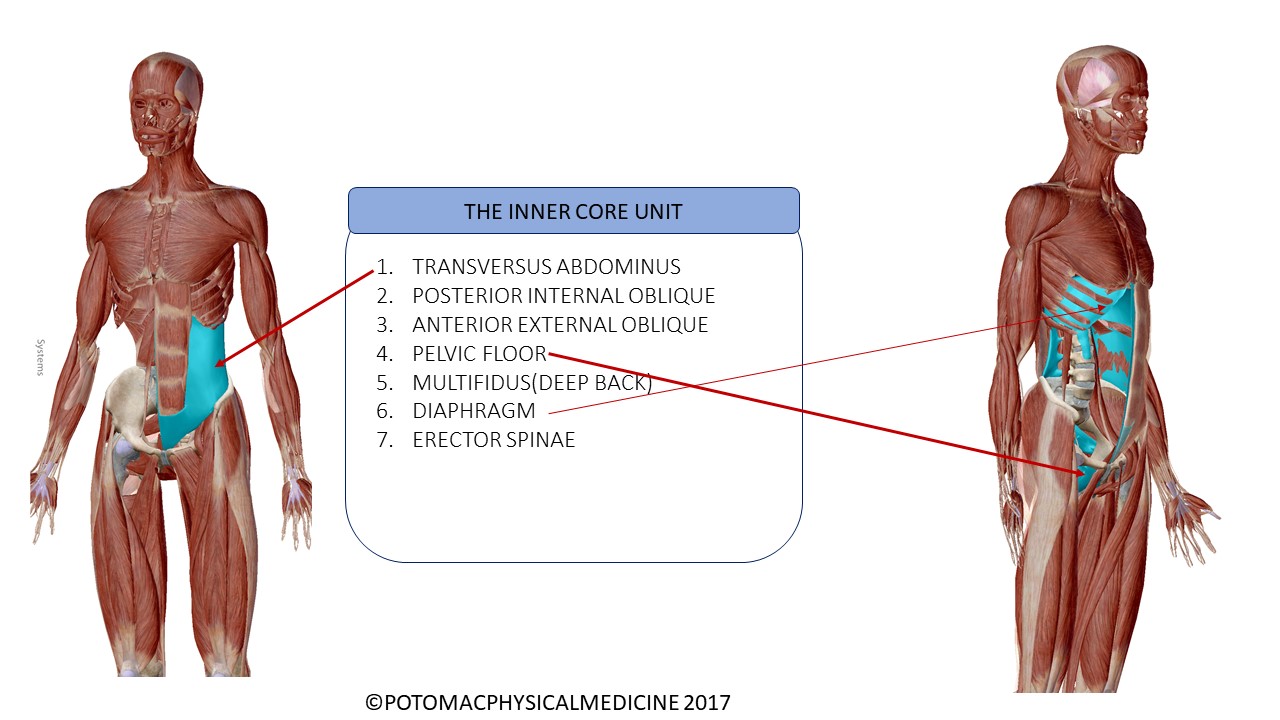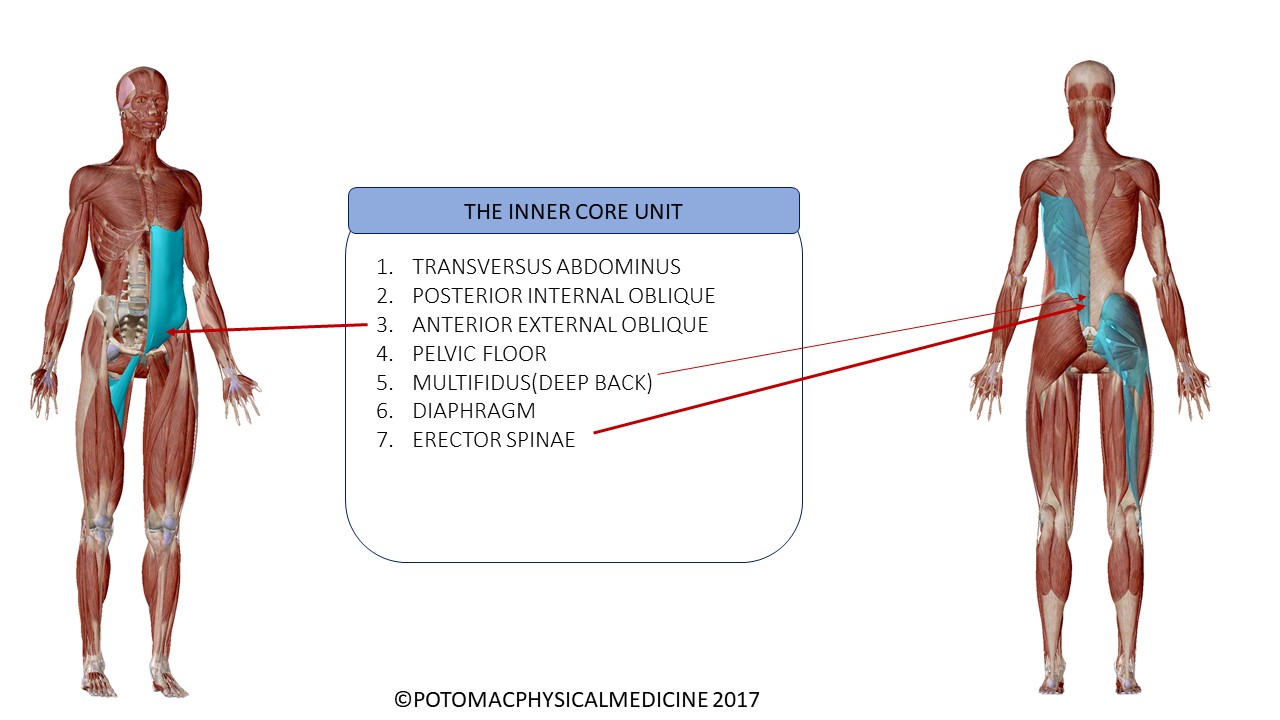
14 Jul DEVELOPING YOUR CORE
by DR MATT FONTAINE
This blog details what we covered in the first session of a 4 week clinic series hosted at Trident CrossFit.
In this 4 Part clinic series we will cover the CORE, LOW BACK & HIPS, SHOULDER, AND FOOT & ANKLE.
Let’s start our discussion with a detailed description of just exactly what the “CORE” is. The human body’s “CORE” is made up of an inner and outer unit.

THE CORE IS MADE UP OF AN OUTER AND INNER UNIT
The Outer Core consists of Abdominals, Gluteals and Erector Spinae

The Inner Core Unit is more complex:
THE INNER UNIT:
- TRANSVERSUS ABDOMINUS
- POSTERIOR FIBERS OF INTERNAL OBLIQUE
- ANTERIOR FIBERS OF EXTERNAL OBLIQUE
- PELVIC FLOOR
- MULTIFIDUS
- DIAPHRAGM
- LOWER ILIOCOSTALIS AND LONGISSIMUS(ERECTOR SPINAE)
THORACOLUMBAR FASCIA CONNECTS DEEP TO THE SPINE THE LATS, THE INTERNAL OBLIQUES AND TVA.
Here are some pictures to better visualize these muscle systems.

THE FOUR SLINGS: THE OUTER UNIT
The muscles around the hips, pelvis and torso develop “four slings” that support the spine and body in a 360 degree orientation. Depending on which position your body is in or moving into, one or more of these slings are at work.
- DEEP LONGITUDINAL SYSTEM( ERECTOR SPINAE/ DORSAL SACRAL LIGAMENTS/ GLUTEALS> BICEPS FEMORIS.
- POSTERIOR LONGITUDINAL SYSTEM: GLUTEALS AND CONTRALATERAL LATISSIMUS
- THE ANTERIOR LONGITUDINAL SYSTEM: ADDUCTORS/IPSILATERAL INTERNAL OBLIQUE> CONTRLATERAL EXTERNAL OBLIQUE
- THE LATERAL SYSTEM: ADDUCTORS, GLUTEUS MEDIUS, QUADRATUS LUMBORUM

The human body’s CORE muscular slings

The human body’s CORE muscular slings
These 4 basic CORE exercises should form the foundation of any athlete’s CORE stability program. A weak CORE effects ALL movement and weakens power force generation through the extremities. Ever attempted to fire a cannon out of a canoe?
REAL EXERCISES
There are many exercises that train the core, but these form the foundation on which all others build.
- THE FRONT PLANK
- THE SIDE PLANK
- THE HIP LIFT OR GLUTEAL BRIDGE
- THE BIRD DOG
HERE IS HOW TO DO THEM
PLANKS: FRONT AND SIDE PLANK VERSIONS.
Start with front plank holds of 10 seconds, repeat 6 times. Over weeks work your endurance up to a static hold of 30 seconds. Then you would repeat 3-4 sets of 30 second holds. For the side plank: start with 5 reps per side, hold each rep at the top for 2-3 seconds. Over a period of weeks, increase the reps to 10 on each side. Again, do 2-3 sets.
GLUTEAL BRIDGE/HIP LIFTS:
Bridge up and hold for 2-3 seconds. Start with 2-3 sets of 10 reps. Advanced bridge: while holding the up bridge position, straighten out one leg and hold for 2-3 seconds. Repeat with the other leg. Do a total of 5 on each side.
BIRD DOG
Aim for 5 -10 reps per side. Keep the pelvis level, reach out with the arm and leg. The thumb should be up toward the ceiling, foot flexed and drive the heel back. Do NOT lift the arm and leg. Instead, reach and get long, this will really activate the core. This exercise is great for the deep muscles of the lower back.
Bonus Video
WHAT EVERY ATHLETE NEEDS TO UNDERSTAND
According to Moore’s Clinical Anatomy, Hilton’s law, espoused by John Hilton in a series of medical lectures given in 1860–1862, states that in human anatomy, the nerve supplying the muscles extending directly across and acting at a given joint also innervate the joint.
It is this law that governs the reason why a fixated, compressed or misaligned joint can and does cause weakness in the muscles that cross that joint.
“Tightness in the hips will cause and inhibition, or weakening of the gluteal muscles. There are those out there on the internet who declare that inhibition of a muscle is a myth, but understand that this is based in hard neuroscience. INHIBITION OF MUSCLES CAN RESULT FROM COMPRESSION OR MISALIGNMENT OF A JOINT OR FROM TIGHTNESS OR HYPERACTIVITY IN THE MUSCLES ON THE OPPOSITE SIDE OF THAT JOINT. OFTEN TIMES PAIN AND OR ARTHRITIS CAN LEAD TO MUSCLE INHIBITION AND WEAKNESS.”
we will cover hips and low back in week # 2 of our series
WHAT ABOUT THE GHD?
THE GLUT HAM DEVELOPER IS ESSENTIALLY A STRAIGHT LEG SIT UP AND SHOULD BE CONSIDERED “A REAL CORE” EXERCISE.
SAME GOES FOR BARBELL ROLL OUTS
WHAT TO BE CAREFUL OF WHEN DOING BARBELL ROLL OUTS:
DO THIS:
ENGAGE YOUR GLUTS BEFORE YOU INITIATE FORWARD MOVEMENT
DON’T DO THIS:
DON’T ROLLOUT FARTHER THAN YOU CAN MAINTAIN COCONTRACTION OF BOTH YOUR ABDOMINALS AND GLUTEALS.
WHAT ABOUT KTE/T2B
Knees to elbow (KTE) and Toes to Bar (T2B) . THESE ARE GYMNASTICS MOVEMENTS THAT CAN HELP BUILD STRENGTH FOR THE PULL UP, BUT THEY ARE ALSO SPINAL FLEXION BASED MOVEMENTS.
REMEMBER THAT ALL “REAL CORE” EXERCISES ARE ONES THAT TRAIN THE CORE’S MAIN FUNCTION> STABILITY, THAT IS CHECKING SPINAL FLEXION AND EXTENSION.
References
- Chek, Paul Scientific Core Conditioning
- Hilton’s Law. Moore’s Clinical Anatomy
- McGill, Stuart 6 Common Myths Around Low Back Pain
ARE YOU A COACH OR GYM OWNER? FIND OUT HOW WE CAN HELP HERE, POTOMAC COACHES CORNER







